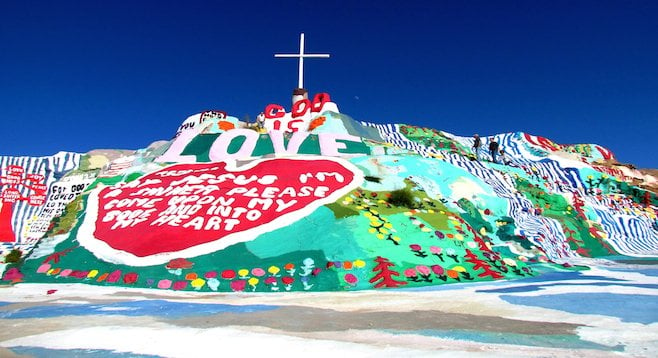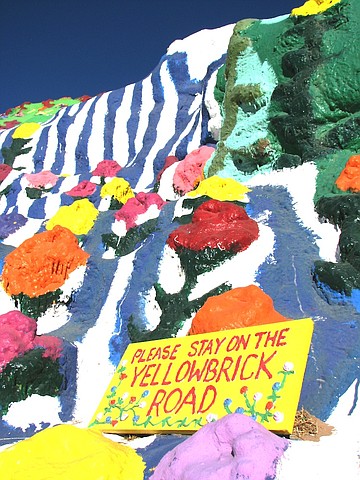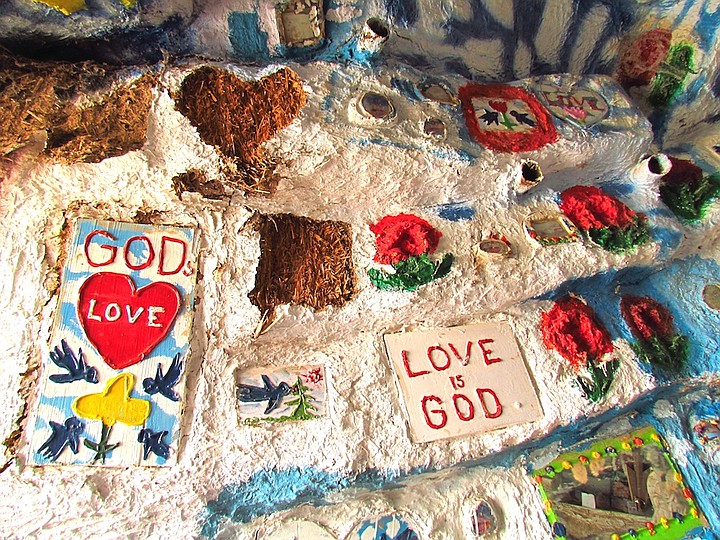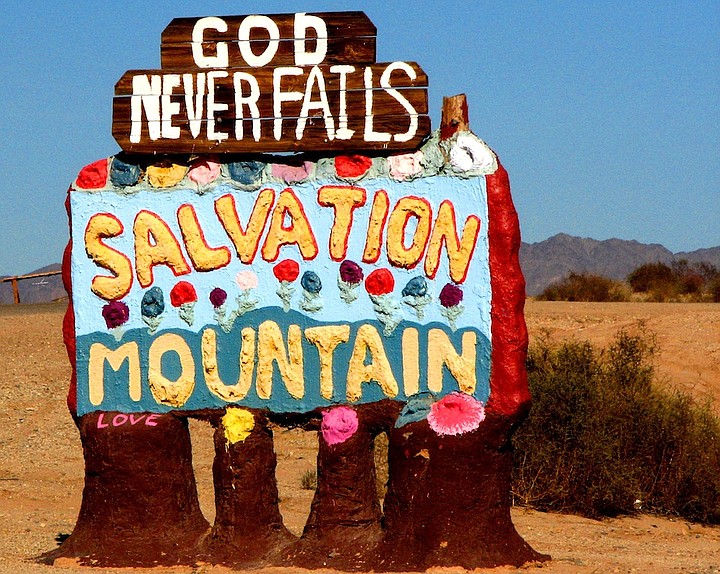 Facebook
Facebook
 X
X
 Instagram
Instagram
 TikTok
TikTok
 Youtube
Youtube

Mahatma Gandhi believed that we should not let the idea of seeing individual actions as insignificant deter us from contributing to and participating in the changes we wish to see.
Apparently, he isn’t alone in that conviction. There are countless legacies created by the actions of individuals who could do nothing but what they were compelled to do. Gandhi, in his wisdom, also recognized that happiness occurs specifically when what we think, say and do are in harmony. Out-of-the-boxers, urban icons or desert recluses driven entirely by the process – the impulse to proceed, to act, to do because to do so brings them joy and peace – seem to demonstrate his point.
Arthur Harold Beal, the “poor man’s Hearst,” found bliss in building a castle in Cambria inexpensively to spite Randolph Hearst; Simon Rodea set out to build “something big” in his spare time, and instead created Watts Towers, now a designated National Historic site that’s been referred to as a “unique monument to the human spirit and the persistence of a singular vision.”
In the old days, this evocation would have been viewed as a calling issued by a higher power, one that could not be ignored. Such individuals were singled out young and protected and pampered as shamans or saints.
People thought Marta Becket, a New York–born and –bred prima ballerina, was out of her blooming mind when she landed in Death Valley Junction with a flat tire, stumbled upon an abandoned theater while her tire was being fixed, and decided to stay. In the almost 40 years that she’s performed on her Amargosa Opera House stage surrounded by self-painted murals, she’s not once regretted staying. More than 100,000 people have traveled from all over the world to see her dance and hear her sing before she retired this past February.

I am fascinated by such people, by those with that very "persistence of singular vision" who carve out their own paths and are motivated solely by their heart’s contentment, who face would-be deterrents as opportunities rather than obstacles, who acknowledge the power in choice in the face of ridicule. I am inspired by people who can do nothing but live by – or through – the force of their unbounded spirit, because they remind me of the basic truth that there's more to life than our 9-to-5 financed, concrete-scaped cul-de-sacs. Not surprising that the root meaning of the word spirit (Greek, “spire”) means "breath" or "life force." You can’t help but feel it when you meet these people or stand before their achievements; you can’t help but feel inspired, in spirit.
Eighty-one year old Leonard Knight would shrug his boney shoulders at me if I suggested that his work at Salvation Mountain, located at the gateway of Slab City in Niland, a two and a half hour drive east of San Diego, was an inspiration, but he’d flat-out deny that it was anything close to a work of art. But it is, and if you’ve ever bothered to make the drive out to this stretch of desert near the Salton Sea, you know this.

Originally from Vermont, born in a town that I know very well, Knight painted the forests, rivers and wildflowers of his Green Mountain state on a 50’ tall, 150’ long mound (left) he constructed out in the desert from strawbales and trash – discarded telephone poles, windows and tires. Crossing his Sea of Galilee, complete with submerged sailboat, to climb the Yellow Brick Road to the cross fixed on the top of his Salvation Mountain leaves the thousands who visit each year (sometimes more than 100 a day) speechless. Not just because they are wondering why anyone would bother to do this – in the middle of a desert – but also because it really is an incredible artistic and structural achievement.
Although religious, Knight is not a churchgoer. He feels ministers often miss the point, the simple point the Bible taught, which he told me was foremost simply To Love. “Keep it simple,” he told me over and over again throughout our talk, “just love.” I couldn't stop smiling.
The sun was beginning to set and I didn’t want to leave his side. We sat in chairs under an awning he had erected aside the painted truck he’s been living in since 1985, when it broke down exactly where it’s been parked ever since. I watched his weathered knobby hands show me his home, his church with its numerous shrines carved from the mountain he built from the ground up. I watched his sagging skin sway as he lifted his arm to point out his birds he had painted on a window now used as a skylight that Sean Penn made famous in the movie Into the Wild. I lingered as he greeted yet another carload of sightseers come to marvel and snap photos. He handed out postcards by the stack and DVDs of a PBS documentary free of charge. People were handing him twenties left and right, which he pushed back at them. I left mine tucked between the next few DVDs in his giveaway pile before taking my leave.
Built on the fault line, the mountain of paint and straw has withstood the strongest of earthquakes. Yet there is some concern whether his legacy will remain now that he’s gone. After having squatted on the vacant land beneath the Chocolate Mountains looking west over the volcanic cones protruding from the Salton Sea for more than a quarter-century, Knight has been placed in long-term care due to dementia.

With the help of apprentices, he'd been working to have his site designated a national heritage site, as Watts Towers in Los Angeles has been. With such designation pending, the fate of Salvation Mountain and his artistic tribute to love is on shaky ground. During a recent return visit, I noticed signs of pillaging in his shrines (left).
As with Becket, Knight had been just passing through. Like her, at first glance, he hadn’t intended to stay in the desert where summertime temps can reach a scorching 115+ degrees. Once he started slapping together his adobe “punch” flowers and his painted mountain began to grow and the visitors came by the busload to the middle of nowhere to meet him and see his work, he knew what he had been called to do. A week became a month became a year became half a lifetime.
Someday soon, these elderly desert icons will return to the dust from which we all arose. And some days later, those like me who sought them out will also pass. There will come the time when no one is alive who once knew them, and their stories will be buried in dusty archives. Knight's mountain will fade in the blazing sunshine and will weather away, slowly decomposing, until nothing is left of his thirty years' work.
For this reason, I tell my children, and now their children, that there is a mountain in the middle of the desert not far from here that an ancient man built out of love. I tell them that he sleeps in an even older truck and that when you climb to the top of his mountain you can see far off to the mountains across the sea. I tell them how I talked with him about the pine forests back in Vermont that we both missed, and how he had trouble remembering from moment to moment but kept asking if I was the lady from Vermont. I tell them his story as he told me, which I know is only a single page in the book. Others elsewhere, no doubt, are doing the same with their grandchildren, sharing another page in Knight’s life story, weaving another colorful thread in the tapestry of his shroud.

People like Knight are remembered long after their contributions to the physical world perish. Even when Salvation Mountain is blown back to level desert dust by decades of neglect, his peaceful generosity and suggestions that we “keep it simple” and “just love one another” will echo in the arid wind rolling like tumbleweed across the mesa.


Mahatma Gandhi believed that we should not let the idea of seeing individual actions as insignificant deter us from contributing to and participating in the changes we wish to see.
Apparently, he isn’t alone in that conviction. There are countless legacies created by the actions of individuals who could do nothing but what they were compelled to do. Gandhi, in his wisdom, also recognized that happiness occurs specifically when what we think, say and do are in harmony. Out-of-the-boxers, urban icons or desert recluses driven entirely by the process – the impulse to proceed, to act, to do because to do so brings them joy and peace – seem to demonstrate his point.
Arthur Harold Beal, the “poor man’s Hearst,” found bliss in building a castle in Cambria inexpensively to spite Randolph Hearst; Simon Rodea set out to build “something big” in his spare time, and instead created Watts Towers, now a designated National Historic site that’s been referred to as a “unique monument to the human spirit and the persistence of a singular vision.”
In the old days, this evocation would have been viewed as a calling issued by a higher power, one that could not be ignored. Such individuals were singled out young and protected and pampered as shamans or saints.
People thought Marta Becket, a New York–born and –bred prima ballerina, was out of her blooming mind when she landed in Death Valley Junction with a flat tire, stumbled upon an abandoned theater while her tire was being fixed, and decided to stay. In the almost 40 years that she’s performed on her Amargosa Opera House stage surrounded by self-painted murals, she’s not once regretted staying. More than 100,000 people have traveled from all over the world to see her dance and hear her sing before she retired this past February.

I am fascinated by such people, by those with that very "persistence of singular vision" who carve out their own paths and are motivated solely by their heart’s contentment, who face would-be deterrents as opportunities rather than obstacles, who acknowledge the power in choice in the face of ridicule. I am inspired by people who can do nothing but live by – or through – the force of their unbounded spirit, because they remind me of the basic truth that there's more to life than our 9-to-5 financed, concrete-scaped cul-de-sacs. Not surprising that the root meaning of the word spirit (Greek, “spire”) means "breath" or "life force." You can’t help but feel it when you meet these people or stand before their achievements; you can’t help but feel inspired, in spirit.
Eighty-one year old Leonard Knight would shrug his boney shoulders at me if I suggested that his work at Salvation Mountain, located at the gateway of Slab City in Niland, a two and a half hour drive east of San Diego, was an inspiration, but he’d flat-out deny that it was anything close to a work of art. But it is, and if you’ve ever bothered to make the drive out to this stretch of desert near the Salton Sea, you know this.

Originally from Vermont, born in a town that I know very well, Knight painted the forests, rivers and wildflowers of his Green Mountain state on a 50’ tall, 150’ long mound (left) he constructed out in the desert from strawbales and trash – discarded telephone poles, windows and tires. Crossing his Sea of Galilee, complete with submerged sailboat, to climb the Yellow Brick Road to the cross fixed on the top of his Salvation Mountain leaves the thousands who visit each year (sometimes more than 100 a day) speechless. Not just because they are wondering why anyone would bother to do this – in the middle of a desert – but also because it really is an incredible artistic and structural achievement.
Although religious, Knight is not a churchgoer. He feels ministers often miss the point, the simple point the Bible taught, which he told me was foremost simply To Love. “Keep it simple,” he told me over and over again throughout our talk, “just love.” I couldn't stop smiling.
The sun was beginning to set and I didn’t want to leave his side. We sat in chairs under an awning he had erected aside the painted truck he’s been living in since 1985, when it broke down exactly where it’s been parked ever since. I watched his weathered knobby hands show me his home, his church with its numerous shrines carved from the mountain he built from the ground up. I watched his sagging skin sway as he lifted his arm to point out his birds he had painted on a window now used as a skylight that Sean Penn made famous in the movie Into the Wild. I lingered as he greeted yet another carload of sightseers come to marvel and snap photos. He handed out postcards by the stack and DVDs of a PBS documentary free of charge. People were handing him twenties left and right, which he pushed back at them. I left mine tucked between the next few DVDs in his giveaway pile before taking my leave.
Built on the fault line, the mountain of paint and straw has withstood the strongest of earthquakes. Yet there is some concern whether his legacy will remain now that he’s gone. After having squatted on the vacant land beneath the Chocolate Mountains looking west over the volcanic cones protruding from the Salton Sea for more than a quarter-century, Knight has been placed in long-term care due to dementia.

With the help of apprentices, he'd been working to have his site designated a national heritage site, as Watts Towers in Los Angeles has been. With such designation pending, the fate of Salvation Mountain and his artistic tribute to love is on shaky ground. During a recent return visit, I noticed signs of pillaging in his shrines (left).
As with Becket, Knight had been just passing through. Like her, at first glance, he hadn’t intended to stay in the desert where summertime temps can reach a scorching 115+ degrees. Once he started slapping together his adobe “punch” flowers and his painted mountain began to grow and the visitors came by the busload to the middle of nowhere to meet him and see his work, he knew what he had been called to do. A week became a month became a year became half a lifetime.
Someday soon, these elderly desert icons will return to the dust from which we all arose. And some days later, those like me who sought them out will also pass. There will come the time when no one is alive who once knew them, and their stories will be buried in dusty archives. Knight's mountain will fade in the blazing sunshine and will weather away, slowly decomposing, until nothing is left of his thirty years' work.
For this reason, I tell my children, and now their children, that there is a mountain in the middle of the desert not far from here that an ancient man built out of love. I tell them that he sleeps in an even older truck and that when you climb to the top of his mountain you can see far off to the mountains across the sea. I tell them how I talked with him about the pine forests back in Vermont that we both missed, and how he had trouble remembering from moment to moment but kept asking if I was the lady from Vermont. I tell them his story as he told me, which I know is only a single page in the book. Others elsewhere, no doubt, are doing the same with their grandchildren, sharing another page in Knight’s life story, weaving another colorful thread in the tapestry of his shroud.

People like Knight are remembered long after their contributions to the physical world perish. Even when Salvation Mountain is blown back to level desert dust by decades of neglect, his peaceful generosity and suggestions that we “keep it simple” and “just love one another” will echo in the arid wind rolling like tumbleweed across the mesa.
Comments